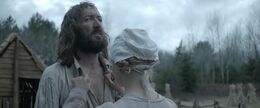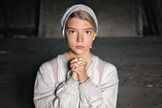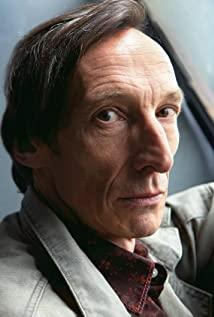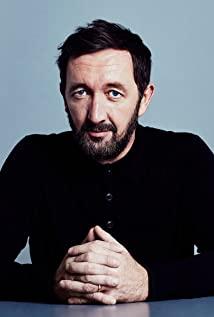Different from ordinary horror movies, the screen of "Witch" is very clean, there are absolutely no harsh screams, ghosts and blood flying towards the screen. It's just so gloomy. The wilderness and dilapidated houses make people feel depressed, while the deep forest opposite the farm is more like a haunt of evil spirits in people's minds. The background of the story is in the 1630s. William and Catherine chose to self-exile, took 5 children, and lived a devout Puritan life near the deserted wilderness. The Puritans were the most pious and holy Protestants in Christianity at the time. They were far from the world and believed that everything was to serve God. The rough life in the suburbs made the family encounter unprecedented difficulties. With the strange disappearance of the youngest son, misfortune and ominousness seem to have begun. However, they had not had time to pass the sadness. More and more weird incidents began to appear. They fell into extreme panic, and the shadow of witches haunted this endangered family. In addition to the relatively closed space, fewer characters, gloomy pictures and proper sound effects, the movie "Witch" is more successful in creating a sense of religious psychological horror. Several horrifying climaxes occurred during the prayers of a family. On one side, humans were reciting the scriptures loudly, and on the other side was the sound of demons attacking. The two voices intersect, and it is no longer clear which side is more creepy. This sense of horror is also long-lasting at the same time, even if you turn off the movie, it still lingers in your heart. In the 16th century, Christianity ruled the secular and spiritual life. The William and his wife always wanted to strictly abide by the Puritan rules. They live simple, self-sufficient lives, and pray on time. Such families should live peacefully and contentedly, but in fact the opposite is true, and their hearts are full of fear. Because they can't really live according to God's commandments. As far as William is concerned, it is the lack of survivability to feed his family, and theft of his wife’s silver cup for food must be concealed; as far as Catherine is concerned, on the one hand, it is the embarrassment of poverty, on the other hand, it is the insight into the alienation of the heart from God; As far as the son is concerned, it is an uncontrollable desire when puberty arrives. What they have done is contrary to Christianity, and they must be punished and go to hell according to the dogma. Let’s look at it from another angle. If they are not Christians, but ordinary parents and children, are these mistakes serious? Fear of life, worries about family fate, and awakening of adolescent sexual consciousness are completely natural and instinct of human beings, and they are nothing more than normal. The reason they are afraid is because these behaviors are not allowed in religion. Faith here is not only absent It saves them from fear, but it aggravates it. The twin siblings in the story are worth discussing separately. Their images remind me of the medieval children's portraits I have seen in historical materials. The children looked like a scaled-down version of adults, without childishness at all. Many records show that there was no concept of "children" in the Middle Ages, and they were even allowed to drink. The behavior of the two young children in the story is also disgusting. They like to tell the truth and frame their sister in front of their mother. (Children in medieval portraits) And sister Thomasine really looks like a normal person. It can even be said that she is the only normal person in the whole family. She is kind and sensible, takes care of her younger brother, and considers her parents. But it is such a young and energetic girl who has been bearing the price of her mother's harsh emotions and her father's stupid mistakes. They have little affection for her and plan to sell her as a maid when the family is in trouble, and even finally identify her as a witch. If the audience does not know the serious consequences of the witch's identification, they may not be able to deeply feel the fear that the film hopes to convey. The witch was heresy in the Middle Ages, and torture and death awaited her. From 1480 to 1780, more than one hundred thousand witches were burned, which became a dark chapter in European medieval history and the history of human civilization. The fact that the parents treated Thomasin this way meant that they completely abandoned their daughter physically and mentally. Religion failed to bring family members close to each other, failed to save them, and instead appeared weak and weak in the face of the cruel life. The William family could have been less difficult. They could either return to life in the town, or face their lack of character and ability, and they could all achieve self-salvation. But they are still struggling with contradictions in their beliefs, and eventually they drive themselves to a dead end. Their pain stems from the confrontation between the free nature of the flesh and the shackles of religion. Religion at this time is by no means tender, but hideous. So when religious symbols such as the Holy Grail, rabbits, crows, and black rams appear in the story, you can think of them as real existences, or you can treat them as concrete representations of everyone's demons. The dense forest on the opposite side represents a place of taboo, as deep as hell on a cold rainy night. The story gradually reached its climax, and the William family died in various absurd ways. It is not so much that the devil turned into a black ram and killed them, it is better to say that they died from their own demons. They couldn't insist on what they abide by, but they were afraid of punishment, and eventually fell into chaos. The only one who survived was Thomasin who was wronged as a witch. In the midst of the madness, she took care of her mother, cutting off the last bond with family and affection. Having nothing, she signed a contract with the black ram and walked naked to the dense forest. "The Witch" has an anti-religious core. story The evil deeds here seem to come from the devil, but what is really terrifying is the oppression and restraint of the human spirit by religion. It cannot provide you with bread, but it stipulates that prayer is more important than bread. At the end of the story, Thomasine saw many witches dancing around the campfire in the dense forest. Those people may be real, and they also fled the crowd because of family and religious harm; maybe that was just her imagination. She finally rose up with a frantic smile, heralding freedom at last. How absurd, a normal human being will eventually become a "heresy" that is not tolerated by society. "The Witch" is the debut work of director Robert Eggers. The film was shortlisted for the competition of the Sundance Film Festival and won the best director award. A small-cost horror film breaks the traditional horror film routine from conception to setting, and its wonderful features are unforgettable. Public Account: The Burning Crusade (tbc1096)
View more about The Witch reviews











